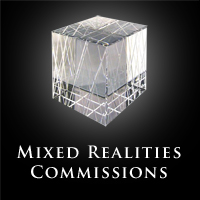June 04, 2007
MIXED REALITIES

Turbulence Awards Five Commissions
Turbulence Commissions: Mixed Realities :: Venues: Ars Virtua (Second Life); Huret & Spector Gallery (Emerson College, Boston); and Turbulence.org :: With funds from the Andy Warhol Foundation for the Visual Arts.
New Radio and Performing Arts, Inc. is pleased to announce the winners of "Mixed Realities," an international juried competition and exhibition. The five commissioned works ($5,000 each) will be exhibited simultaneously at Ars Virtua (Second Life), Huret & Spector Gallery (Boston), and Turbulence.org in spring 2008. They are:
IMAGING KALININGRAD: THE SEVEN BRIDGES OF KOENIGSBERG by John (Craig) Freeman; REMOTELY COUPLED DEVICES (WORKING TITLE) by Usman Haque, Georg Tremmel and Neill Zero; NO MATTER by Scott Kildall and Victoria Scott; THE VITRUVIAN WORLD by Michael Takeo Magruder, Drew Baker and David Steele; and CATERWAUL by Pierre Proske, with technical assistance from Artem Baguinski and Brigit Lichtenegger.
KALININGRAD AND THE SEVEN BRIDGES OF KOENIGSBERG by John (Craig) Freeman is an extension of Freeman’s "Imaging Place" project; a place-based, immersive, virtual reality project that takes the form of a user navigated, interactive computer program combining panoramic photography, digital video, and three-dimensional technologies to investigate and document situations where the forces of globalization are impacting the lives of individuals in local communities. The famous Swiss mathematician Leonard Euler invented Topology--the key to understanding how networks are formed--in the city of Konigsberg, now Kaliningrad, in 1735. When Euler visited the city, there were seven bridges connecting the city's center to the banks of the Pregel River. A favorite pastime for visitors was to try to solve the puzzle of whether or not a person could walk throughout the city and cross each of the bridges exactly once. Freeman will retrace the imaginary steps of Leonard Euler across these seven bridges. Users will be able to navigate the virtual space as the story of the seven bridges unfolds, as well as the story of how globalization is impacting this remote Russian city. Full proposal.
REMOTELY COUPLED DEVICES by Usman Haque, Georg Tremmel and Neill Zero: This proposal takes as its starting point that the distinction between 'virtual' and 'real' is as quaint as the nineteenth century distinction between 'mind' and 'body'. As such, the spaces of Ars Virtua and Huret & Spector Gallery will be treated equivalently. A device will be constructed for each space which--via the EnvironmentXML framework--will enable people around the world to build remote devices and environments that respond in real time to the local environmental conditions of the two galleries. A Java applet and historical data repository, residing on the Turbulence.org server, will enable the tracking of real time and historical sensory data from the two locations as well as the connections that people make over time. Full proposal.
NO MATTER by Scott Kildall and Victoria Scott: No Matter is an interactive installation that translates the psychology of the Second Life virtual economy into physical space. Virtual economies--where artificial currencies are exchanged in online worlds for dematerialized goods and services--are presently impacting the ‘real’ economy. The leakage of one to another appears on eBay, on the SL Exchange and through virtual land brokers. This mixed economic model overturns established relationships between labor and production. As specialty items can be obtained at a fraction of their real world cost, our perception of the value of objects becomes further obscured. No Matter reflects this conflation of imaginary and real economics by: (1) commissioning the creation of imaginary objects in Second Life; (2) inviting viewers to re-construct these immaterial 3D objects in physical space; (3) paying them Second Life wages; and (4) reselling the replicas on eBay. Full proposal.
THE VITRUVIAN WORLD by Michael Takeo Magruder, Drew Baker and David Steele: In the 1st century BC, Roman writer, architect and engineer Vitruvius authored specific building formulae based on the guiding principles of strength, utility and beauty. For him, architecture is intrinsically linked to nature and is an imitation of cosmic order. The most well-known interpretation of this postulate is the Vitruvian Man by Leonardo da Vinci in which the human form is depicted in unity with the square and circle--representing material and spiritual existence respectively. Given that this tripart union of human body, material form and spiritual essence maintains relevance within the current climate of distributed presence, mixed realities and internet culture, The Vitruvian World will embody the principles of Vitruvius within a contemporary context. Full proposal.
CATERWAUL by Pierre Proske, with technical assistance from Artem Baguinski and Brigit Lichtenegger: When someone screams in real life, do they hear us in virtual reality? Do they want to? The proliferation of networked online worlds has provided a small quota of the human race the option to seek refuge in utopian, less troubled imaginary lands. Rolling synthetic green pastures offer us respite from a planet undergoing exploitation and climate change. For those of us too firmly rooted in this material world to join them, how shall we communicate with them? In what way shall we lament their departure? The essence of Caterwaul is a large, monolithic, dark wall that is represented both in the real and virtual worlds. It is a one-way portal to the virtual world through which people can whisper their thoughts, scream their frustrations and convey regret without the privilege of reply. It is a wailing wall through which to mourn the loss of our humanity to the virtual network. Full proposal.
The competition was juried by Yasmine Abbas, Founder, Neo-Nomad; Michael Frumin, Technical Director Emeritus, Eyebeam; James Morgan, Director, Ars Virtua; Trebor Scholz, Founder, Institute for Distributed Creativity; and Helen Thorington, Co-Director, Turbulence.
Posted by jo at June 4, 2007 06:50 PM
